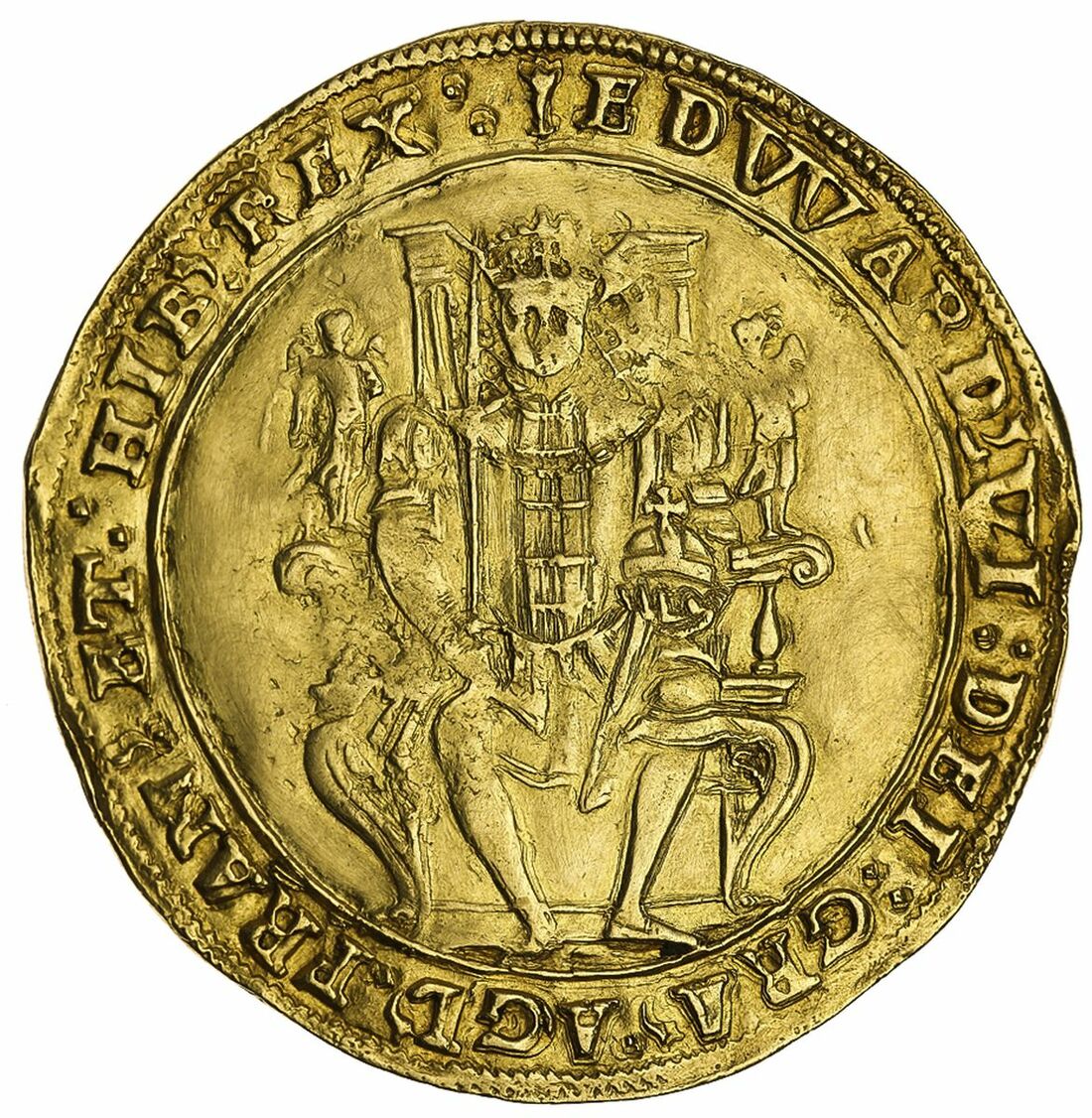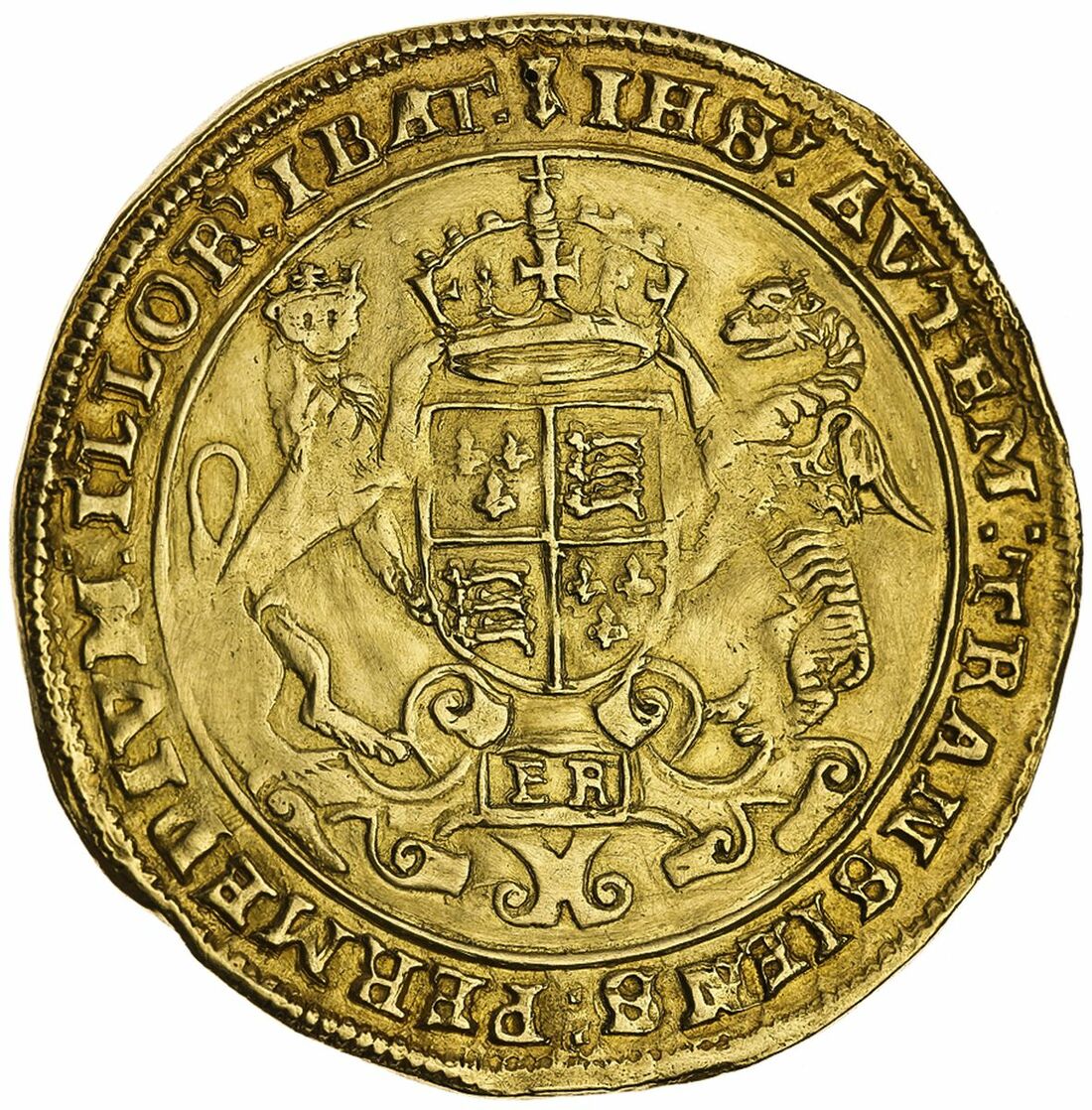Auction: 23006 - The Official COINEX Auction at Spink
Lot: 132
The 'Eleutherios' Collection | Edward VI (1547-1553), Second Period, 'Third Year' Sovereign, January 1548/9 - June 1549 [OS], Tower [Under-Treasurer, Sir Martin Bowes], (m.m.) EDWARD .' VI : DEI : GRA .' AGL '. FRAN .' ET : HIB .' REX : Edward seated facing on decorated throne, holding upraised sword and orb, small square stops, rev. (m.m.) IHS .' AVTEM : TRANSIENS : PER MEDIVM : ILLOR .' IBAT : Royal coat-of-arms with crowned leopard and griffin supporters; all set on ornate frame with central titulus inscribed ER, small square stops, 10.83g [167.1grns], 1h, m.m. arrow / arrow over inverted arrow (Snelling, Pl. III, - [no. 12 for type]; Ruding, Pl. VII, - [no. 2 for type]; Cuff [1854], -; Kenyon [1884], p. 109 and Pl. X, 70 var.; Montagu [1896] -; Murdoch I 461 same dies ~ fine, very rare ~ 167.5grns; Bruun [1925] -; Earl of Ducie [1949], 15 = Rashleigh [1953], 28 = M W Hall [1963], 122 = Thos H Law, 20072 same dies; Raynes [1950] -; Ryan [1950] -; Lockett [1956], 1857 = Dabney-Thompson = SNC, April 1973 same dies; Hird -; Beresford-Jones 42 same dies; Baumhauer III, 1074 same dies; Potter, p. 135; Schneider I, 668 same dies; North 1906; Spink 2433), a minute hole by reverse mintmark and traces of smoothing in fields, otherwise residually lustrous and lightly toned in peripheries, uniformly struck on a round flan, only about very fine, but an EXTREMELY RARE variety remarkably overlooked on account of the more instantly-recognisable Third Period specie; with only EIGHT examples recorded from a single die-pairing, this coin as rare as the much-vaunted 'Ostrich head' Angel of the same 'Boy King' and made ever more appealing thanks to its rightfully re-established pedigree since last offered publicly!
Provenance
The 'Eleutherios' Collection of English Coins
Baldwin of St. James's, Auction 18, 7 June 2018, lot 144 - £11,500
Jonathan P Rosen, CNG Triton XXI, 9 January 2018, lot 1426 - $9,500
Professor D C Baker, Spink 161, 14 November 2002, lot 46 - "tooled in fields on both sides, otherwise neatly struck and round, very fine, very rare" - £5,500 [Rosen]
Patrick Finn, FPL 15, January 1999, no. 13* - "very lightly tooled in both fields, but a pleasing coin and otherwise VF+ and very rare" - £4,500
E Fletcher, Glendining, 13 December 1937, lot 64* - "very fine and very rare" - The Spink library copy states 'tooled' - £20.0.0 [Dr Gibson]
C Corbally-Browne, Sotheby's, 25-28 March 1935, lot 250* - "very fine and very rare" - The Spink library copy states 'very cleaned, scarcely VF' - £34.0.0 [Dr Gibson]
Glendining, 20-21 December 1927, lot 3 - "Edward VI, Sovereign, m.m. arrow, EDWARD’ VI: DEI: GRA : AGL: FRAN ET: HIB’ REX: King holding sword and orb seated on high-backed throne, rev. IHS! AVTEM TRANSIENS : PERMEDIVM: ILLOR’ IBAT, shield with supporters ER on a tablet below, very rare and fine, but has had field burnished" - £14.10.0
J G Langton († 1918), not listed in his little-known posthumous sale at Glendining (6 February 1919), but evidently sold privately alongside his wider collection of English Hammered Gold Coins that had been acquired from amongst others: the Murdoch [1903]; O'Hagan [1907] and Hilton-Price [1909] cabinets - a further tranche of which featured anonymously as: 'A Collection of Gold Coins, The Property of a Gentleman' (Sotheby's, 21 April 1911, lots 174-250), where again this coin was omitted
R Manley-Foster, Sotheby's, 3-5 November 1903, lot 81 - "very rare and fine, the field unfortunately damaged by burnishing" - £5.5.0 [Langton]
The Second Period coinage opened with the Proclamation of 24 January 1549 (Harley MS. 38) 'stating that the King, to the intent that money might be more plentifully and richly made, had caused certain new coins to be struck, namely the 20s., 10.y. or Edward royall, 5s. and 2s. 6d. in gold, shillings and half shillings' (H. Symonds, op. cit., p. 136). On the same day a commission was signed and sent to Sir Edmund Peckham, the treasurer, and Sir Martin Bowes, under-treasurer at the Tower mint, ordering the striking of this coinage. The terms are not known as the document is missing though mentioned in Bowes's accounts. There is little doubt, however, that they were the same as those embodied in the similar commission which has survived to John Bowes, treasurer of the mint within the king's manor of Durham House, Strand, dated 29 January 1548/9, ordering him to strike the four coins of crown gold according to the proclamation and the two coins of 8-oz. silver. The 4-oz. groats and smaller money of the previous indenture were to be continued. Potter, writing the above in his 1962 BNJ treatise, added the following: "The sovereigns are of a separate design from the smaller pieces and were apparently struck only in the first six months of 1549 as they are known of the marks arrow and Y only. I have noted two pairs of dies of each mark. The design is an enlarged version of that used for the half-sovereigns of the first period, with the king seated facing on the throne, the only difference being that he now wears tunic and breeches instead of the royal robes." (BNJ, 1962, p. 135)
There are two varieties of issue for the Tower, signed with the 'arrow' pyx mark. Historically this has been mistaken for an ermine, or otherwise described as a pheon and even 'a bolt' in 19th Century catalogue descriptions.
Subject to 20% VAT on Buyer’s Premium. For more information please view Terms and Conditions for Buyers.
Sold for
£9,000
Starting price
£6500









